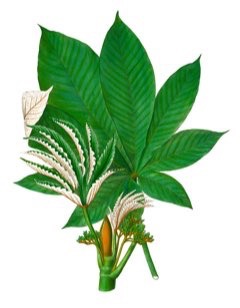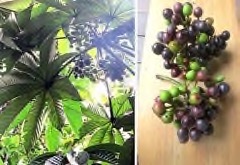 |
|
http://www.edibleplants.org |
 |
| Dick Culbert wikimedia.org |
Translate this page:
Summary
Physical Characteristics

 Pourouma cecropiifolia is an evergreen Tree growing to 15 m (49ft) by 7 m (23ft) at a fast rate.
Pourouma cecropiifolia is an evergreen Tree growing to 15 m (49ft) by 7 m (23ft) at a fast rate.
See above for USDA hardiness. It is hardy to UK zone 10.
Suitable for: medium (loamy) and heavy (clay) soils and prefers well-drained soil. Suitable pH: mildly acid, neutral and basic (mildly alkaline) soils. It can grow in semi-shade (light woodland) or no shade. It prefers moist soil.
UK Hardiness Map
US Hardiness Map
Synonyms
Pourouma edulis Dufr. Pourouma multifida Tr?cul Pourouma sapida P.Karst. Pourouma uvifera Rusby
Plant Habitats
Edible Uses
Edible Parts: Fruit
Edible Uses: Drink
Fruit - raw or cooked[301 ]. The purple, grape-like fruits are up to 4cm in diameter, with a large seed and a sweet, juicy, white pulp that has the flavour of a grape[46 , 301 ]. They can be made into wine, jams and jellies[301 ]. The fruits are produced in clusters[335 ].
References More on Edible Uses
Medicinal Uses
Plants For A Future can not take any responsibility for any adverse effects from the use of plants. Always seek advice from a professional before using a plant medicinally.
Poultice
The warmed bark is used as a poultice for treating hard boils[348 ].
References More on Medicinal Uses
The Bookshop: Edible Plant Books
Our Latest books on Perennial Plants For Food Forests and Permaculture Gardens in paperback or digital formats.

Edible Tropical Plants
Food Forest Plants for Hotter Conditions: 250+ Plants For Tropical Food Forests & Permaculture Gardens.
More

Edible Temperate Plants
Plants for Your Food Forest: 500 Plants for Temperate Food Forests & Permaculture Gardens.
More

More Books
PFAF have eight books available in paperback and digital formats. Browse the shop for more information.
Shop Now
Other Uses
Containers Wood
Other Uses: The wood is light, soft and easy to work[420 ]. It has a thick texture, poor mechanical properties and is not very durable[420 ]. It is used for linings, boxes, toys and plywood[420 ]. It is also pulped for cellulose[420 ].
Special Uses
Food Forest
References More on Other Uses
Cultivation details
A tree of the hot, humid, tropical lowlands, where it is found at elevations up to 1,000 metres[335 , 420 ]. It is not tolerant of frost[335 ]. Succeeds in full sun or dappled shade[420 ]. Found in the wild on fertile, clayey soils[420 ]. A relatively fast-growing plant, it can commence fruiting when three years old[301 ]. A dioecious species, both male and female forms need to be grown if fruit and seeds are required.
References Carbon Farming Information and Carbon Sequestration Information
Temperature Converter
Type a value in the Celsius field to convert the value to Fahrenheit:
Fahrenheit:
The PFAF Bookshop
Plants For A Future have a number of books available in paperback and digital form. Book titles include Edible Plants, Edible Perennials, Edible Trees,Edible Shrubs, Woodland Gardening, and Temperate Food Forest Plants. Our new book is Food Forest Plants For Hotter Conditions (Tropical and Sub-Tropical).
Shop Now
Plant Propagation
Seed - best sown as soon as it is ripe in a seedbed in a sunny position[420 ]. Less than 50% of the seeds usually germinate, normally within 3 - 5 weeks[420 ].
Other Names
If available other names are mentioned here
Washi shuinia, Mapati, Caimaron, Curcura, Peruma, Uva, Uvula,
Native Range
SOUTHERN AMERICA: Venezuela (Amazonas), Brazil (Acre, Amazonas (west)), Bolivia (El Beni, Pando), Colombia (Amazonas, Caquetá, Meta, Putumayo, Vaupés), Ecuador (Morona Santiago, Napo, Pastaza), Peru (Amazonas, Huánuco, Junín, Loreto, Madre de Dios, Pasco, San Martín, Ucayali)
Weed Potential
Right plant wrong place. We are currently updating this section.
Please note that a plant may be invasive in one area but may not in your area so it's worth checking.
Conservation Status
IUCN Red List of Threatened Plants Status : This taxon has not yet been assessed

Growth: S = slow M = medium F = fast. Soil: L = light (sandy) M = medium H = heavy (clay). pH: A = acid N = neutral B = basic (alkaline). Shade: F = full shade S = semi-shade N = no shade. Moisture: D = dry M = Moist We = wet Wa = water.
Now available:
Food Forest Plants for Mediterranean Conditions
350+ Perennial Plants For Mediterranean and Drier Food Forests and Permaculture Gardens.
[Paperback and eBook]
This is the third in Plants For A Future's series of plant guides for food forests tailored to
specific climate zones. Following volumes on temperate and tropical ecosystems, this book focuses
on species suited to Mediterranean conditions—regions with hot, dry summers and cool, wet winters,
often facing the added challenge of climate change.
Read More
Expert comment
Author
Mart.
Botanical References
Links / References
For a list of references used on this page please go here
A special thanks to Ken Fern for some of the information used on this page.
Readers comment
| Add a comment |
|
If you have important information about this plant that may help other users please add a comment or link below. Only comments or links that are felt to be directly relevant to a plant will be included. If you think a comment/link or information contained on this page is inaccurate or misleading we would welcome your feedback at [email protected]. If you have questions about a plant please use the Forum on this website as we do not have the resources to answer questions ourselves.
* Please note: the comments by website users are not necessarily those held by PFAF and may give misleading or inaccurate information.
To leave a comment please Register or login here All comments need to be approved so will not appear immediately.
|
Subject : Pourouma cecropiifolia
|
|
|
|